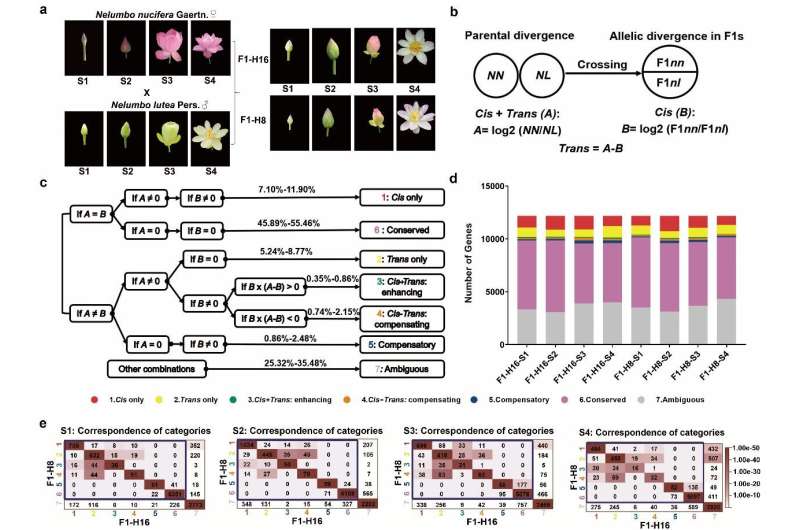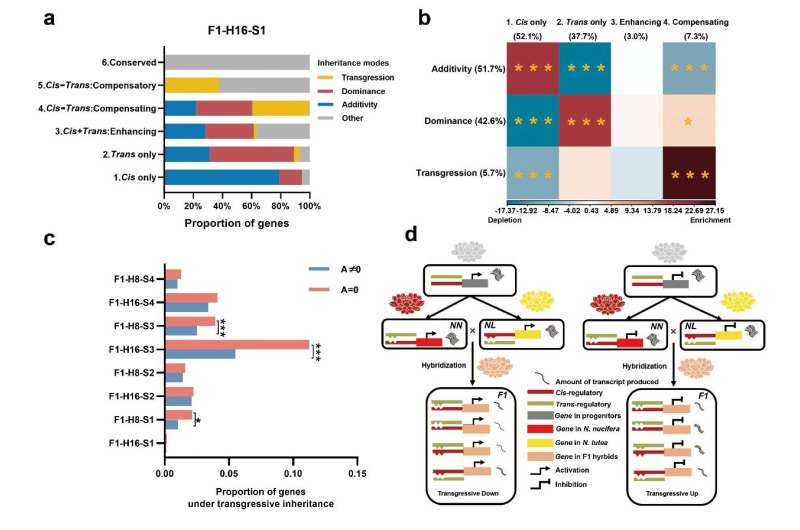This article has been reviewed according to Science X's editorial process and policies. Editors have highlighted the following attributes while ensuring the content's credibility:
fact-checked
trusted source
proofread
Cis-and trans-regulatory variants affect flower color differentiation between lotus species

Gene expression rewiring often contributes to phenotypic evolution between newly diverged species. Changes in gene expression patterns can be caused by mutations in either cis-regulatory regions (promoter) of the gene itself or trans-acting regulatory genes (transcription factors). However, the effects of cis-and trans-regulatory variants at the whole genome level of gene expression leading to phenotypic differentiation in floral organs during the closely related newly diverged species are not very clear.
Researchers from the Wuhan Botanical Garden of the Chinese Academy of Sciences (CAS) selected two lotus species, Nelumbo nucifera with red flowers and Nelumbo lutea with yellow flowers in Nelumbo, and their F1 hybrids as experimental subjects. Based on single nucleotide polymorphisms from re-sequencing and transcriptome sequencing among parents and F1 hybrids, the global allele-specific expression analysis was carried out to uncover the relative contributions of genome-wide cis-and trans-regulatory divergences to differentiation of flower color in interspecies.
Combined with contents of total anthocyanidins and carotenoids in high-performance liquid chromatography, they focused on the role of cis-and trans-regulatory variants on key genes involved in anthocyanin and carotenoid biosynthesis pathways.
The results revealed that trans-regulatory variants had higher correlations on the differentiation of gene expression in petal tissues between the two species. And genes with significantly higher expression in N. lutea tended to be regulated by trans-regulatory variants.
In addition, hub genes in modules from anthocyanin-and carotenoid-related weighted co-expression networks were preferentially regulated by trans-only with dominant inheritance, which involved the rewiring of the anthocyanin and carotenoid gene regulatory networks between the two species.

Genes with different regulatory categories preferred a specific inheritance mode of gene expression in F1 hybrids. Genes under cis-only and trans-only regulation were significantly enriched for additive inheritance and dominant inheritance, respectively.
Additionally, genes under antagonistic cis-and trans-effects (cis-trans compensating regulatory variants and cis-trans compensatory regulatory variants) showed significant enrichment of transgressive inheritance.
In pleiotropic constraints, genes with trans-only regulation exhibited a relatively broader expression breadth and a higher expression level than genes with cis-only regulation. They were more likely to be retained after whole-genome duplication in lotus and be subjected to higher selective sweep pressure.
There were multiple known genes under cis-and trans-regulatory variants in modules from Weighted Correlation Network Analysis involved in anthocyanin biosynthetic pathway and carotenoid biosynthetic pathway.
The anthocyanin 5- aromatic acyltransferase gene underwent cis-trans compensating regulation and the glutathione s-transferase F11 gene with cis-trans enhancing regulation exhibited much higher expression in N. nucifera to promote anthocyanin accumulation.
The expression level of the lycopene ε-cyclase gene was significantly higher in N. lutea to promote carotenoid accumulation, suggesting cis-and trans-regulatory variants involved in the rewiring of the anthocyanin and carotenoid gene regulatory networks.
The expression differences of these three genes had important impacts on the flower color differentiation between the two lotus species. The results from this study provide a new perspective on the genetic mechanism of phenotypic polymorphism in Nelumbo.
This study was published in Plant Physiology, titled "Expression inheritance and constraints on cis-and trans-regulatory mutations underlying lotus color variation."
More information: Zhiyan Gao et al, Expression inheritance and constraints on cis- and trans-regulatory mutations underlying lotus color variation, Plant Physiology (2022). DOI: 10.1093/plphys/kiac522
Provided by Chinese Academy of Sciences





















